Search results for: 'stone a'
-
 Neolithic axe head with through hole
Neolithic axe head with through holeFinely crafted tool from the New Stone Age of Europe. Made from greenish grey rock. With a through hole at the neck as a remarkable feature.
Price: on request Paleolithic hand axe
Paleolithic hand axePrehistoric stone tool. It was the universal tool of the older Stone age and could be used as a borer or a cutter. From a Swiss museum collection. Found in Algeria, North Africa.
Price: on request Paleolithic hand axe
Paleolithic hand axePrehistoric stone tool. It was the universal tool of the older Stone age and could be used as a borer or a cutter. From a Swiss museum collection. Found in Morocco, North Africa.
Price: on request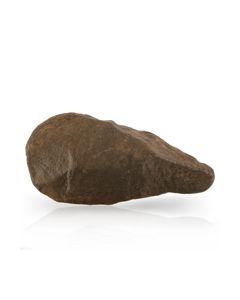 Paleolithic hand axe
Paleolithic hand axePrehistoric stone tool. It was the universal tool of the older Stone age and could be used as a borer or a cutter. From a Swiss museum collection. Found in the Algerian Sahara desert.
Price: on request Paleolithic hand axe
Paleolithic hand axePrehistoric stone tool. It was the universal tool of the older Stone age and could be used as a borer or a cutter. From a Swiss museum collection. Found in the Algerian Sahara desert.
Price: on request Large prehistoric hand axe
Large prehistoric hand axeMassive Paleolithic stone tool. It was the universal tool of the older Stone age and could be used as a borer or a cutter. From a Swiss museum collection. Found in Algeria, North Africa.
Price: on request Large Paleolithic hand axe
Large Paleolithic hand axePrehistoric stone tool. It was the universal tool of the older Stone age and could be used as a borer or a cutter. From a Swiss museum collection. Found in Foggaret Ezzaouia, Algeria, North Africa.
Price: on request Paleolithic hand axe
Paleolithic hand axePrehistoric stone tool. It was the universal tool of the older Stone age and could be used as a borer or a cutter. From a Swiss museum collection. Found in Erg Mehedjibat, Algeria, North Africa.
Price: on request Large Paleolithic hand axe
Large Paleolithic hand axePrehistoric stone tool. It was the universal tool of the older Stone age and could be used as a borer or a cutter. From a Swiss museum collection. Found in Erg Mehedjibat, Algeria, North Africa.
Price: on request Paleolithic hand axe
Paleolithic hand axePrehistoric stone tool. It was the universal tool of the older Stone age and could be used as a borer or a cutter. From a Swiss museum collection. Found in Erg Mehedjibat, Algeria, North Africa.
Price: on request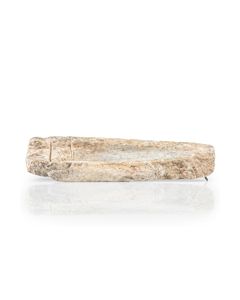 Bronze Age casting mould for a chisel
Bronze Age casting mould for a chiselOne half of a stone mould for bronze casting. The equipment is from a workshop of the 2nd Millennium BC, probably from the Carpathian Basin. From the famous Guttmann Collection. This mould was published in a work by Born and Hansen.
Price: on request Sassanian intaglio with griffin
Sassanian intaglio with griffinPerfectly preserved ring stone made of orange carnelian. It shows a winged hybrid creature with the body of a lion. With inscription in Pahlavi, the Middle Persian script of the Sassanids.
Price: on request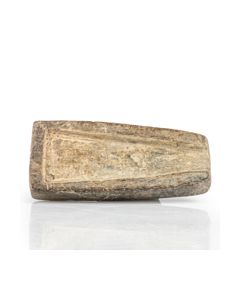 Bronze Age casting mould for a flat axe
Bronze Age casting mould for a flat axeOne half of a stone mould for bronze casting an axe head. The equipment is from a workshop of the 2nd Millennium BC, probably from the Carpathian Basin. From the famous Guttmann Collection. This mould was published in a work by Born and Hansen.
Price: on request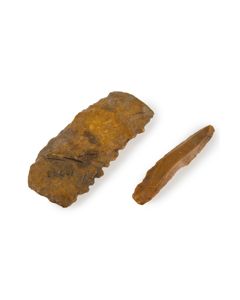 Two Neolithic stone tools from Egypt
Two Neolithic stone tools from EgyptThe Stone Age saw and the slender blade are finely worked. From a 100 year old museum collection.
Price: on request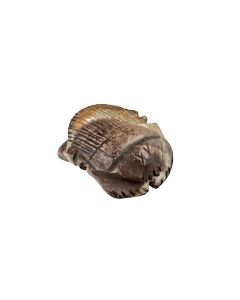 Scarab made of banded stone
Scarab made of banded stoneThis fantastic funerary scarab captivates with the beautiful banded stone it was made of. A piece from the Greco-Roman period.
Price: on request Egyptian model vessels of a founding ceremony
Egyptian model vessels of a founding ceremonyA group of seven miniature bowls and three miniature vases made of clay. Once filled with offerings and used ritually during a foundation stone laying ceremony. Dating to the Old Kingdom, around 2500 BC.
Price: on request Conoid stamp seal
Conoid stamp sealMade from beautiful mottled stone during Iron Age II. The seal is from southern Anatolia or northern Syria and is engraved with a religious scene.
Price: on request Egyptian green stone vessel
Egyptian green stone vesselThe stone vessel is made of beautiful green serpentine. From the collection of Egyptologist Professor Wiedemann. Middle Kingdom of Ancient Egypt.
Price: on request Small axe head from the New Stone Age
Small axe head from the New Stone AgeCompact stone axe from the 3rd Millenium BC. Found on the Danish island of Moen.
Price: on request Six neolithic stone tools
Six neolithic stone toolsNice group of artefacts from the Northern European Neolithic. One blade, two dagger fragments and three axe head fragments. All found in Northern Germany.
Price: on request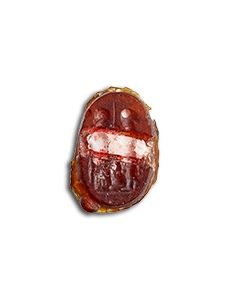 Roman intaglio with two warriors
Roman intaglio with two warriorsThe scene shows two warriors in a conversation. The glass imitates natural stone with a white inclusion.
Price: on request Egyptian stone beaker
Egyptian stone beakerThe elegant stone vase was probably used as an ointment vessel. 5th to 6th dynasty of ancient Egypt, Old Kingdom.
Price: on request Slender Egyptian stone beaker
Slender Egyptian stone beakerThe small and tall stone vessel is made of alabaster. From the collection of Egyptologist Professor Wiedemann.
Price: on request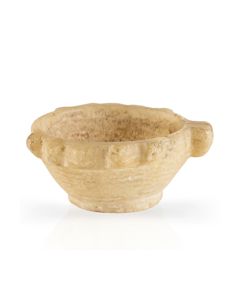 Egyptian alabaster bowl from Luxor
Egyptian alabaster bowl from LuxorThe small stone vessel is an offering bowl for libation. From the collection of Egyptologist Professor Wiedemann. 12th to 18th dynasty of Ancient Egypt
Price: on request Egyptian alabaster vessel
Egyptian alabaster vesselLarge container for this type of vessel. A thin-walled and very skilfully crafted specimen. Made between the 12th and 18th dynasty of Ancient Egypt.
Price: on request Egyptian stone vessel from Luxor
Egyptian stone vessel from LuxorThe cosmetic vessel is of a rare type. From the collection of Egyptologist Professor Wiedemann. Middle Kingdom of Ancient Egypt
Price: on request Small Egyptian stone vessel
Small Egyptian stone vesselNice stone vessel and rare type from the Middle Kingdom. Timelessly elegant shape.
Price: on request Paleolithic hand axe or borer
Paleolithic hand axe or borerPrehistoric stone tool. It was the universal tool of the older Stone age and could be used as a borer or chisel. From a Swiss museum collection. Found in the Algerian Sahara desert.
Price: on request Egyptian Kohl vessel
Egyptian Kohl vesselThe small stone pot of nicely polished granite was used for Kohl, the eye cosmetic of the ancient Egyptians. From the time between Middle Kingdom and New Kingdom.
Price: on request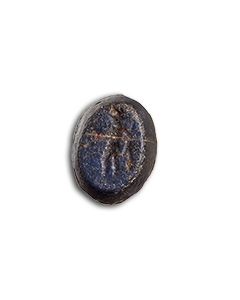 Ancient intaglio
Ancient intaglioA scene with a young man is moulded into dark blue glass. Insert stone dating to Roman Imperial times.
Price: on request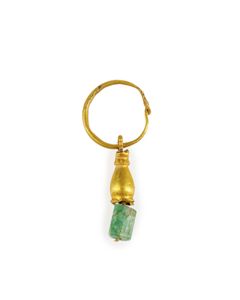 Roman gold earring with emerald
Roman gold earring with emeraldBeautiful jewellery from the 2nd century made of gold with a green stone bead.
Price: on request Small Egyptian Kohl vessel
Small Egyptian Kohl vesselThe stone pot was used for Kohl, the eye cosmetic of the ancient Egyptians. Vessel with well preserved body and missing rim. From the 2nd Millenium BC.
Price: on request Small Egyptian Kohl vessel
Small Egyptian Kohl vesselThe stone pot was used for Kohl, the eye cosmetic of the ancient Egyptians. Vessel with well preserved body and missing rim. From the 2nd Millenium BC.
Price: on request Polished stone age axe head
Polished stone age axe headThe small tool from the younger Stone Age has a nicely polished surface revealing the beautiful black stone it is made of. Approx. 4200 to 2400 BC.
Price: on request Small Stone Age axe made of rock
Small Stone Age axe made of rockThe tool with finely polished blade is of the point-butted type. From the Stone Age of western Europe.
Price: on request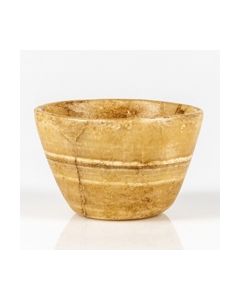 Egyptian stone bowl
Egyptian stone bowlThis wonderful bowl of banded stone was probably used for ritual purposes. From the Early Dynastic Period or Old Kingdom of ancient Egypt.
Price: on request

